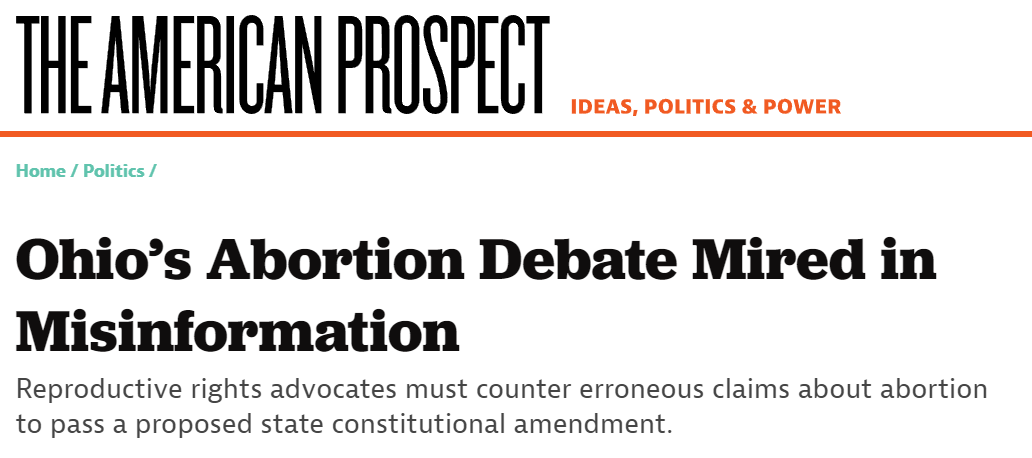Welcome to DU!
The truly grassroots left-of-center political community where regular people, not algorithms, drive the discussions and set the standards.
Join the community:
Create a free account
Support DU (and get rid of ads!):
Become a Star Member
Latest Breaking News
Editorials & Other Articles
General Discussion
The DU Lounge
All Forums
Issue Forums
Culture Forums
Alliance Forums
Region Forums
Support Forums
Help & Search
General Discussion
Showing Original Post only (View all)Ohio's Abortion Debate Mired in Misinformation [View all]

https://prospect.org/politics/2023-10-13-ohios-abortion-debate-misinformation/

One distinctive feature of the Ohio abortion debate is that doctors and other reproductive rights–minded health care professionals have emerged as a potent coalition, steering public opinion from the moment that the Supreme Court struck down Roe v. Wade. Last year, 1,000 physicians in the state threw down an unambiguous challenge, “A Message to Our Patients on the Loss of Reproductive Rights,” which outlined their objections to political excesses like Dobbs v. Jackson Women’s Health Organization and Ohio’s “heartbeat bill,” and listed some of the key reasons—chemotherapy, unviable pregnancies, rape—that lead women to undergo an abortion. Ohio Physicians for Reproductive Rights (OPRR), the group behind the campaign that had been originally spearheaded by two outraged doctors, also hammered home the “sanctity and privacy of the patient-physician relationship” and labeled the assault on women’s medical freedom of choice and criminalizing doctors “un-American.” Across the country, other statewide, doctor-led organizations have sprung up to protect reproductive rights.
OPRR helped launch the citizen-backed reproductive rights constitutional amendment (known as “Issue 1”) that appeared on the general-election ballot. It is one of only two issues up for statewide consideration this year in Ohio, vastly eclipsing what otherwise might be the main event, a ballot initiative legalizing recreational marijuana. The pathway to the ballot has been long and complicated, punctuated by a six-week trigger ban that has been blocked by the courts twice. The biggest confrontations erupted over how the wording of the proposed amendment would appear on the general-election ballot. This high-profile struggle between abortion supporters and opponents over the politicized language, and the efforts by Ohio media outlets to introduce important context, is a master class in the misinformation campaigns that have been unleashed in conservative states.
In August, the five-member Ohio Ballot Board, which has a Republican majority, decided that instead of using the actual text of the proposed amendment, it would provide a summary, a not-so-unusual move in these kinds of elections. The first paragraph of the official summary on the secretary of state’s website begins, “The proposed amendment would: Establish in the Constitution of the State of Ohio an individual right to one’s own reproductive medical treatment, including but not limited to abortion.” The actual text of the proposed amendment, which is not on the ballot, provides examples of reproductive care that the summary omits, namely “including but not limited to contraception [access]; fertility treatment; continuing one’s own pregnancy; miscarriage care; and abortion,” which abortion rights supporters wanted included to show the other reproductive health matters that deserved constitutional protections. In particular, they sought the inclusion of contraception access, which some lawmakers have identified as a possible next target of state reproductive prohibitions.
What is more unusual is that the ballot summary uses charged phrases like “unborn child” instead of medical terms like “fetus.” It uses the term “viability” but fails to explain it, even though the full text of the amendment does provide a definition for “fetal viability.” The Ohioans United for Reproductive Rights coalition (the physicians’ group is a member) argued in its lawsuit seeking to correct these and other major mischaracterizations in a summary that was “irrevocably flawed.” The Ohio Supreme Court, which has a Republican majority of elected justices, agreed to one small technical change. But the justices let other disputed elements stand. Media outlets like Signal Cleveland, a local community site, doubled down on explainers with interactive features contrasting the current summary language with issues raised by the coalition, while others like the Ohio Capital Journal launched a series specifically devoted to the amendment’s language and the rights it would affect.
snip
3 replies
 = new reply since forum marked as read
Highlight:
NoneDon't highlight anything
5 newestHighlight 5 most recent replies
= new reply since forum marked as read
Highlight:
NoneDon't highlight anything
5 newestHighlight 5 most recent replies